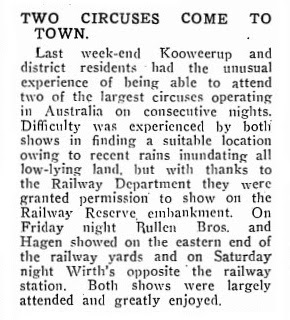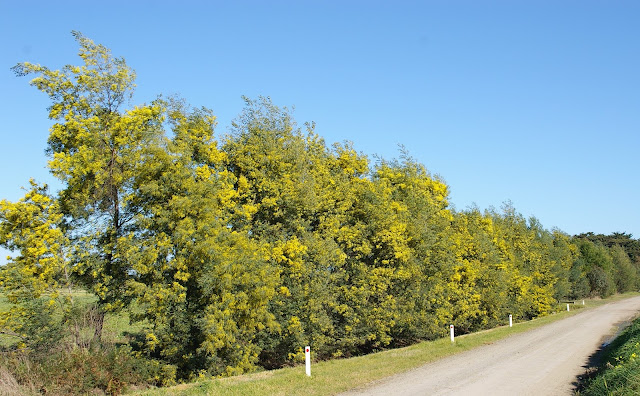School No. 2629
In 1884, School No. 2629 was built on the corner of Bayles Road and Bethune’s Road. It was originally known as Yallock, but changed its name to Koo Wee Rup in 1903. The school officially opened on November 1, 1884 and the first Head teacher was Eva Hurst with an initial enrolment was 22 pupils. Miss Hurst was replaced by Mary Dodd, who was in turn replaced by Mrs Grace MacKenzie in 1888. There was agitation, from as early as 1891, to have the school location moved closer to the town of Koo Wee Rup, which was growing due partly to the arrival of the railway in 1890.
The school population moved into the Public Hall in Rossiter Road in 1909 and in the September of 1910 classes moved to the original school building, which had been shifted into town to the site where the Secondary College now stands. Mrs MacKenzie left the school in 1911 to take up a new appointment at Moolort. The original school building became redundant when a new building was opened in February 1915 and this old building eventually became the Island Road School. In 1953, the Higher Elementary School was completed. This school included both primary and secondary classes (Forms 1 to 3 or Years 7 to 9). The school became a High School in 1957 and shared the building with the primary school students until November 1960 when the Primary School opened in Moody Street.
School No. 3198
On July 7, 1894, the Koo Wee Rup South School, No. 3198, opened at Five Mile, on the corner of Main Drain Road and Five Mile Road. The building was previously located at San Remo School. This school has the distinction of starting its life called Koo Wee Rup South and then having its name changed to Koo Wee Rup North.
Peter Norris was the first Head Teacher. At one time the school population was over 100 but in July 1954 when the school celebrated its 60th anniversary there were only 20 children enrolled. However, the anniversary celebrations were a great success with over 700 people attending, including three original scholars - W. Gilchrist, W.G. De Vries and Tilly Freeman (nee O’Shea). The school parents voted for the school to close in November 1959 and the children were sent to Pakenham Consolidated School (read a short history of the school, here). Five Mile was the last school to join or ‘consolidate’ with the Consolidated School which had officially opened in May 1951. Read more about the Koo Wee Rup North school, here.
When the Iona School, No. 3201, opened two days after the Five Mile School on July 9, 1894, on the corner of Thirteen Mile Road and Bunyip River Road, it was called Koo Wee Rup North; in 1899 it changed its name to Bunyip South and then in 1905 to Iona. This school closed in December 1993. Read more about the Iona State School, here.
School No. 3456
School No. 3456 was opened on April 1, 1903 in Modella in temporary premises in a room in a private house. At the time the area and the school was known as Koo Wee Rup East. The school moved to its permanent location, on the corner of Longwarry-Koo Wee Rup Road and Bridges Road in January 1904. On February 16, 1905, the school officially changed its name to Modella. The first teacher was Frederick Rumpff and he was there until 1907. There was then a series of short-term appointments including Dorothy Sillett, who was there in 1908. Her report in the Teacher Records file at the Public Records Office, says she was inexperienced, but anxious to do her best. Dorothy was 20 years old and had only been teaching since April 1907. Given that she was the sole teacher at the school, and that she would have been isolated by lack of transport coupled with the low pay of female teachers it is no surprise that her few months at Modella marked the end of her teaching career with the Education Department. The Modella school closed in December 1993.
School No. 3502
In January 1907 the Koo Wee Rup Central School (No. 3502) was built at Cora Lynn. The first Head Teacher was John McGibbon. On July 9, 1907, Mr McGibbon wrote to the Education Department…..on July 1st the Postal authorities granted the residents here a postal service and in compliance with a general request, named the district Cora Lynn. Hence, we should like the school to bear the name likewise. Again, great delay and inconvenience are caused by parcels and letters addressed to Koo Wee Rup Central S.S. first going to Koo Wee Rup S.S., or Koo Wee Rup South or Koo Wee Rup East before finally coming to hand. This annoyance would cease with the change of name. By September of the same year its name was changed to Cora Lynn. This school became part of Pakenham Consolidated School in May 1951.
Sources
- From Three to Ninety three: ninety years of education at Modella by Shirley Breese (The School, 1993)
- On the edge of the swamp: a history of the Iona Primary School No. 3201 1894-1994 by Denise M. Nest (Iona Primary School Back-To-Committee, 1994)
- Schooling on the Swamp: a history of Primary School No.2629 Koo Wee Rup 1884-2009 by Don Jewell (Koo Wee Rup Primary School, 2009)
- The tale of the Blackfish: a history of the Koo Wee Rup High School 1957-1977 by Fred Hooper (Koo Wee Rup High School, 1977)
- Vision and Realisation: a centenary history of State Education in Victoria edited by Les Blake (Education Department of Victoria, 1973)
- Notes on the history of Cora Lynn State School, compiled by Bryan Sim, Education History Services of the Education Department in 1984.






















































